
La Earthcache / The Earthcache
La collégiale Saint-Aubin est une église au style gothique trônant au cœur de la cité guérandaise.
Construite principalement avec une roche plutonique locale, le Leucogranite de Guérande, elle dévoile dans la chair de ses flancs des veines riches en joyaux cristallins.
► Le Leucogranite de Guérande, roche QFM
Le Granite de Guérande est un vaste batholite mis en place dans la partie nord de la presqu'ile guérandaise il y a 320 Ma, au paroxysme de l'orogenèse hercynienne.
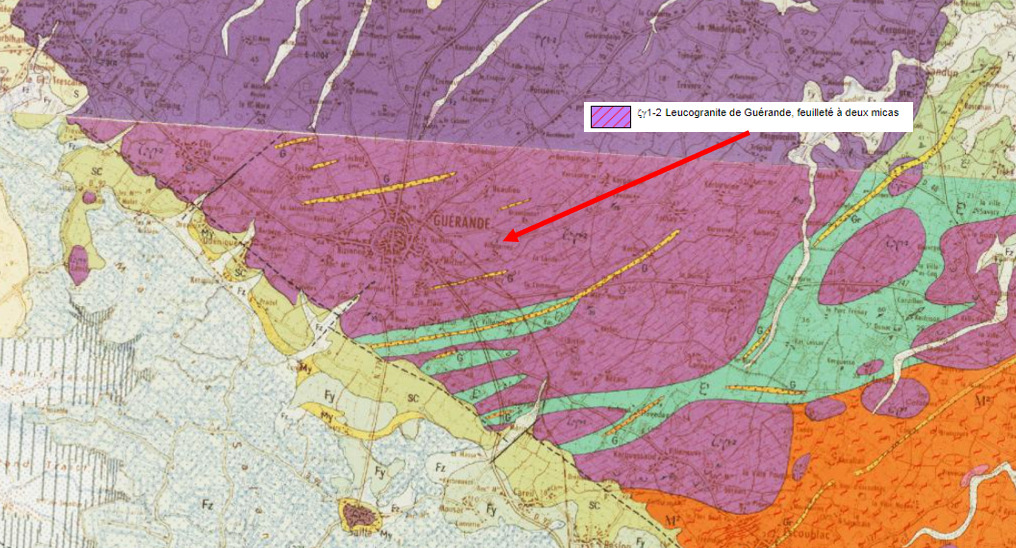
C'est une roche cristalline claire, généralement assez grossière (grains millimétriques).
Cette teinte claire s'explique par sa composition chimique QFM :
- du Quartz en cristaux globuleux translucides gris.
- des Feldspaths plagioclases sodiques avec des cristaux d'albite blanc en abondance.
- du Mica avec une proportion nettement supérieure en muscovite (mica blanc) qu'en biotite (mica noir ferromagnésien).
C'est cette relative pauvreté en ferromagnésien (et donc à contrario sa richesse en éléments siliceux) qui en sont le principal déterminisme, comme on peut le voir sur le diagramme de Streckeisen :
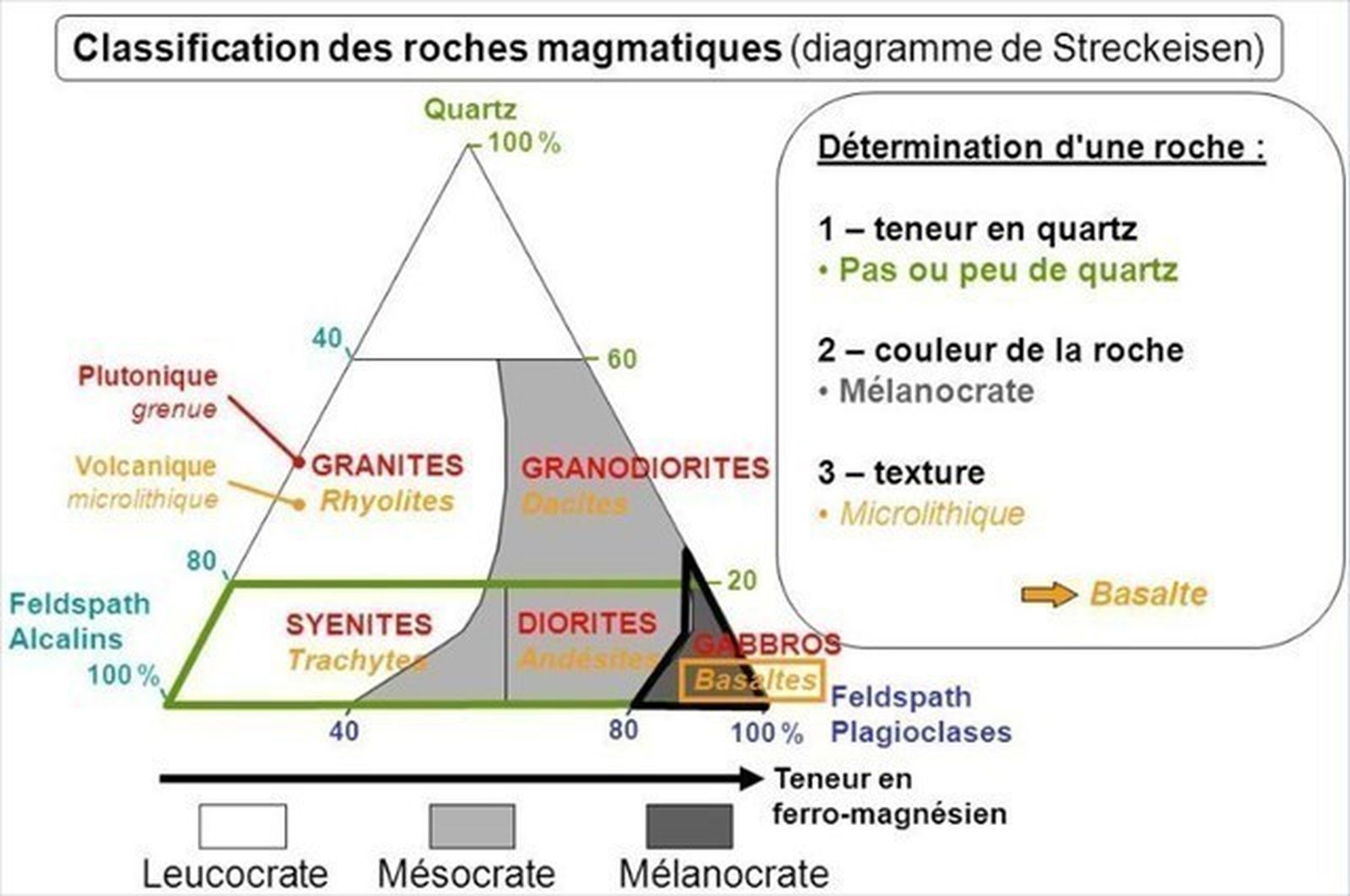
►Les veines du leucogranite et ses cristaux
~ Jus anatectique et pegmatites
Le batholite de leucogranite de Guérande va subir après sa mise en place des contraintes liées à la poursuite de l'orogenèse hercynienne, avec deux conséquences :
- La fracturation du batholite, le granite étant une roche très peu ductile.
- La fusion partielle du leucogranite en un jus pegmatique causée par des augmentations locales de pression et de température et facilitée par la composition minérale du leucogranite.
En effet, voici les températures de fusion d'un matériel QFM (en présence d'eau) :
- Vers 650°C, fusion du quartz et des feldspaths.
- Vers 750°C, fusion du mica blanc (muscovite).
- Vers 850°C, fusion du mica noire (biotite).
Le jus anatectique issu de la fusion partielle de l'encaissant va s'infiltrer dans les fractures créées puis cristalliser de nouveau sous la forme de filons de pegmatites à gros cristaux (phénocristaux).
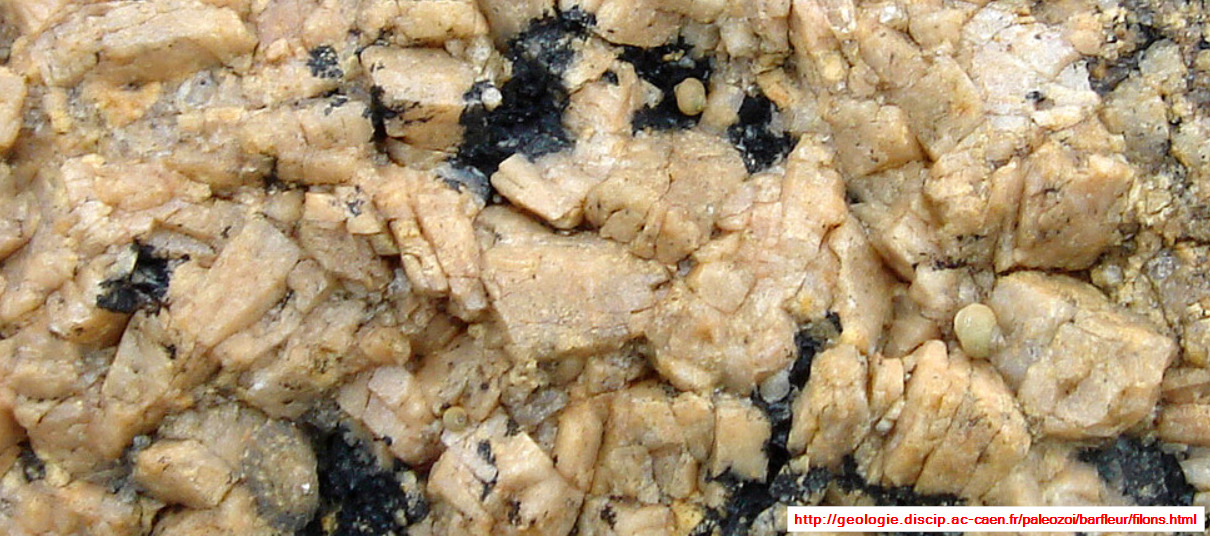
Comme tout liquide magmatique qui cristallise, la taille des cristaux va dépendre de la vitesse de refroidissement du magma (plus elle est lente, plus les cristaux sont gros).
Les cristaux se développant librement, ils vont prendre une forme automorphe, c'est à dire celle d'un cristal parfait ou au moins limité par des faces cristallines planes.
~ Structure cristalline automorphe des minéraux granitiques.
La forme automorphe d'un cristal va dépendre de sa structure cristalline qui se décline en 7 formes géométriques de base appelées "prismes".

- Le Quartz
Il se présente sous la forme de grands cristaux incolores, colorés ou fumés, transparent à translucide.
Sa structure cristalline de base est trigonale. Ce système trigonal peut cependant prendre deux symétrie différente : rhomboédrique et hexagonal.
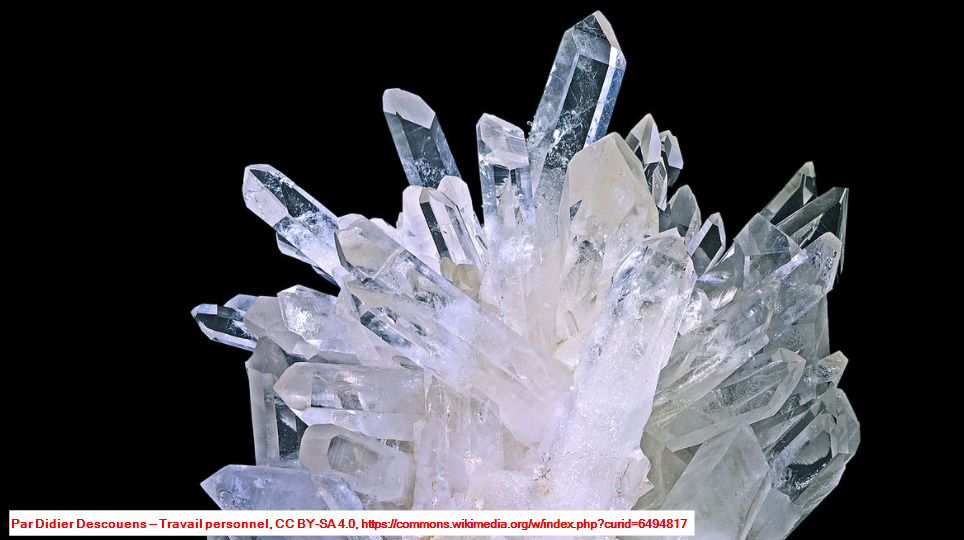
- L'Albite
Ce feldspath sodique est opaque et tient son nom du latin albus, blanc en allusion à sa couleur.
Les cristaux automorphes vont se présenter en massifs ou en cristaux tabulaires maclés avec un prisme triclinique, c'est à dire une base et des formes en parallélogramme.

- La Muscovite
Le mica blanc, ou muscovite, tient son nom de son éclat nacré et soyeux qui reflète les rayons du soleil comme un miroir.
Sa structure cristalline de base est monoclinique (base rectangle ; faces rectangles et parallélogrammes) donnant une forme de feuillets avec des proportions [long+ , large+ , haut-].
Ces feuillets en lamelles vont souvent se superposer en de très nombreuses couches détachables, donnant au phénocristal une impression de mille-feuilles.

- La Tourmaline
Il existe de nombreuses variétés de tourmaline mais la forme la plus courante dans les pegmatites et les granites est la variété Schorl de couleur noire et à l'éclat vitreux.
Sa structure cristalline de base est trigonale, mais elle va prendre une symétrie hexagonal, donnant une forme prismatique à six pans avec des faces alternativement larges et étroites.

The Saint-Aubin collegiate church is a Gothic-style church enthroned in the heart of the Guérande city.
Built mainly with a local plutonic rock, the Guérande Leucogranite, it reveals in the flesh of its sides veins rich in crystalline jewels.
► Leucogranite from Guérande, QFM rock
The Guérande Granite is a vast batholith put in place in the northern part of the Guérande peninsula 320 Ma ago, at the height of the Hercynian orogeny.
It is a clear crystalline rock, generally quite coarse (millimeter grains).
This light shade is explained by its chemical composition QFM:
- Quartz in translucent gray globular crystals.
- sodium plagioclase feldspars with abundant white albite crystals.
- Mica with a much higher proportion of muscovite (white mica) than in biotite (black ferromagnesian mica).
It is this relative poverty in ferromagnesium (and therefore on the contrary its richness in siliceous elements) which are its main determinism, as can be seen on the Streckeisen diagram.
► The veins of leucogranite and its crystals
~ Anatectic juice and pegmatites.
The Guérande leucogranite batholith will undergo, after its installation, constraints linked to the continuation of the Hercynian orogeny, with two consequences:
- Fracturing of the batholith, granite being a very poorly ductile rock.
- The partial melting of leucogranite into a pegmatic juice caused by local increases in pressure and temperature and facilitated by the mineral composition of leucogranite.
Indeed, here are the melting temperatures of a QFM material (in the presence of water):
- Around 650 ° C, fusion of quartz and feldspars.
- Around 750 ° C, fusion of white mica (muscovite).
- Around 850 ° C, fusion of black mica (biotite).
The anatectic juice resulting from the partial fusion of the surrounding material will infiltrate the fractures created and then crystallize again in the form of seams of pegmatites with large crystals (phenocrysts).
Like any magmatic liquid which crystallizes, the size of the crystals will depend on the speed of cooling of the magma (the slower it is, the larger the crystals).
The crystals developing freely, they will take an automorphic shape, that is to say that of a perfect crystal or at least limited by flat crystal faces.
~ Automorphic crystalline structure of granitic minerals.
The automorphic shape of a crystal will depend on its crystalline structure which comes in 7 basic geometric shapes called "prisms".
- Quartz
It occurs as large colorless, colored or smoky crystals, transparent to translucent.
Its basic crystal structure is trigonal. This trigonal system can however take two different symmetry: rhombohedral and hexagonal.
- L'Albite
This sodium feldspar is opaque and takes its name from the Latin albus, white in allusion to its color.
The automorphic crystals will appear in massive or twin tabular crystals with a triclinic prism, that is to say a base and parallelogram shapes.
- Muscovite
White mica, or muscovite, takes its name from its pearly, silky sheen that reflects the sun's rays like a mirror.
Its basic crystal structure is monoclinic (rectangle base; rectangular and parallelogram faces) giving the shape of sheets with proportions [long +, wide +, high-].
These lamellae sheets will often overlap in numerous detachable layers, giving the phenocrystal an impression of mille-feuilles.
- Tourmaline
There are many varieties of tourmaline but the most common form in pegmatites and granites is the black colored Schorl variety with a glassy luster.
Its basic crystal structure is trigonal, but it will take a hexagonal symmetry, giving a six-sided prismatic shape with alternately wide and narrow faces.
► Sources bibliographiques / Bibliographical sources
Les Questions / The Questions
La lecture attentive du descriptif de la cache, ainsi qu'une observation des éléments de terrain et un peu de déduction sont normalement suffisants pour répondre aux questions de cette EarthCache.
A careful reading of the description of the cache, as well as observation of terrain features and some deduction is usually sufficient to answer questions of this EarthCache.
Questions pour valider :"Joyaux cristallins à Saint-Aubin"
Questions to validate: "Crystal gems in Saint-Aubin"
- Question 0 : Prenez une photo de vous ou d'un élément vous identifiant avec la Collégiale Saint Aubin en arrière plan (sans les zones d'observation).
Cette photo devra au choix nous être transmise avec les réponses ou être ajoutée à votre log.
- Question 0 : Take a photo of yourself or of an element that identifies you with the Collegiate Church of Saint Aubin in the background (without the observation areas)
This photo will have to be sent to us with the answers or to be added to your log.
Point 1 : N 47° 19.674 W 002° 25.750
Avec la photo WP1, repérez le bloc sous la zone rouge A, qui contient une zone bleue B.
With photo WP1, locate the block under the red area A, which contains a blue area B.
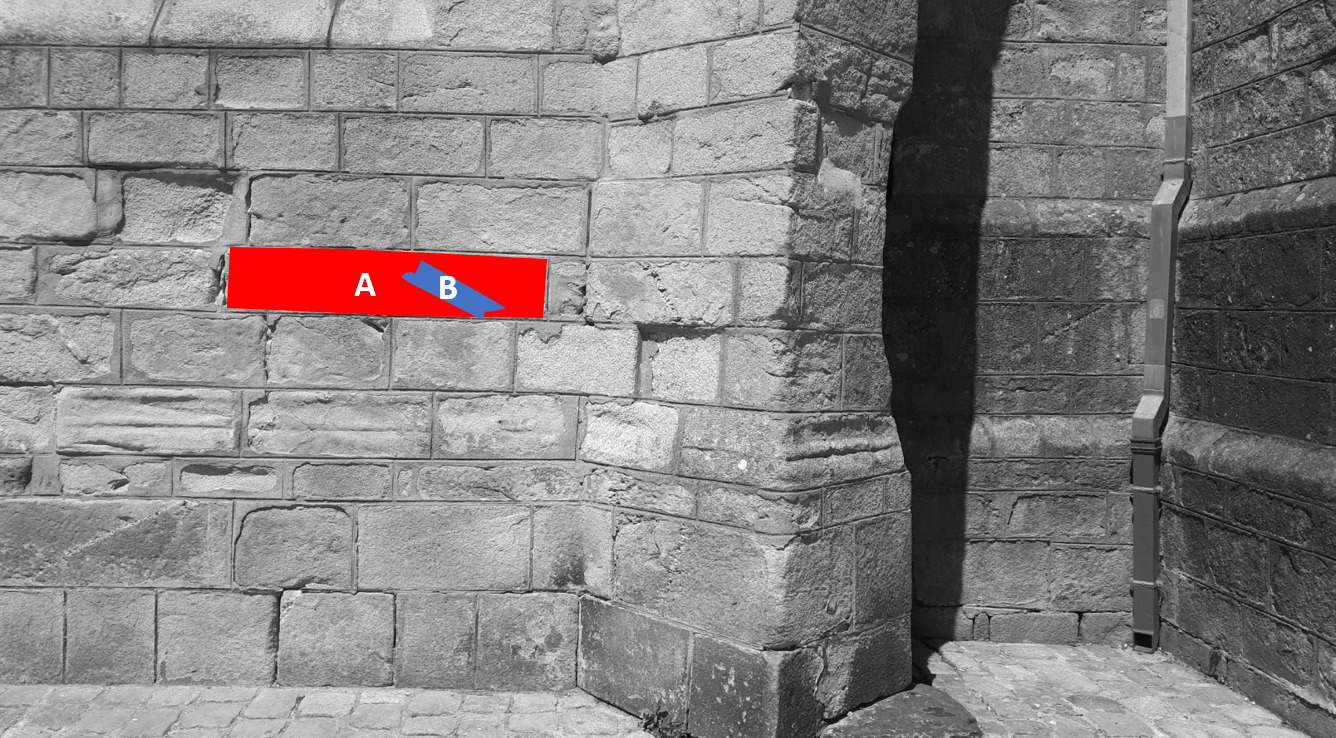
- Question 1 : Etudiez les caractéristiques de la zone A avec le diagramme de Streckeisen et déduisez la nature de la roche.
- Question 1 : Study the characteristics of zone A with the Streckeisen diagram and deduce the nature of the rock.
- Question 2 : Comparez la texture de la roche entre la zone A et la zone B. Laquelle des deux s'est cristallisée le plus lentement ?
- Question 2 : Compare the texture of the rock between zone A and zone B. Which of the two crystallized more slowly?
- Question 3 : Dans la zone B, Observez les cristaux automorphes les plus gros. En fonction de leur couleur, éclat et forme de leur système cristallin, déduisez-en leur nature.
- Question 3 : In area B, observe the largest automorphic crystals. According to their color, brightness and shape of their crystal system, deduce their nature.
Point 2 : N 47° 19.674 W 002° 25.750
Décalez vous de 20 mètres vers la droite (voir photo WP2 puis la zone zoomée dans le carré bleu).
Shift 20 meters to the right (see photo WP2 then the zoomed area in the blue square).
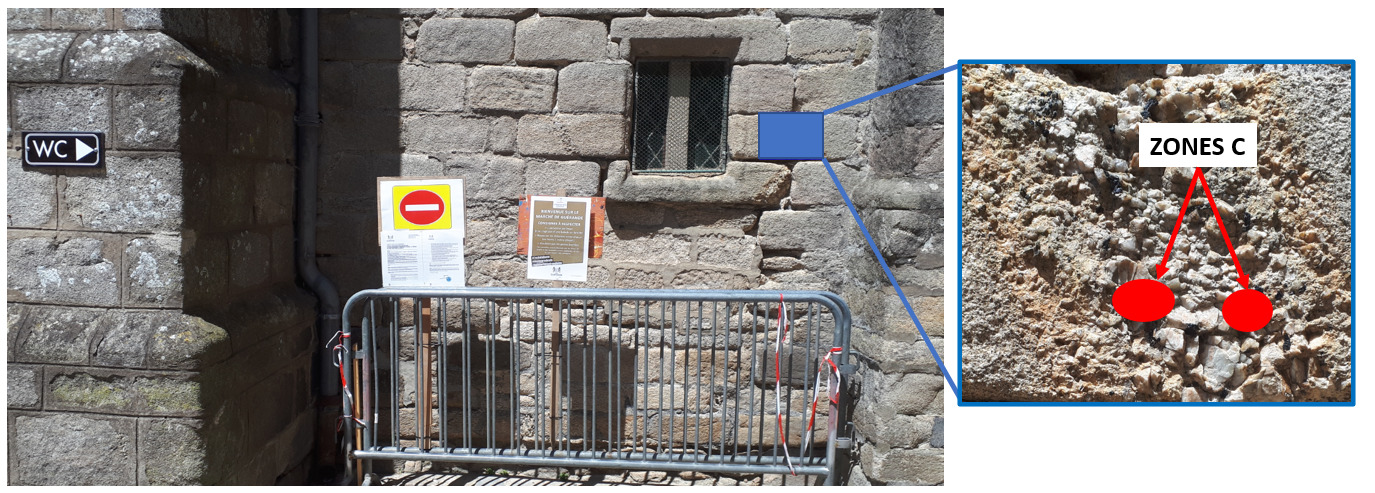
- Question 4 : Décrire la structure cristalline des phénocristaux sous les zones rouges C du zoom. Si vous ajoutez la couleur, quel minéral QFM prend cette structure ? Déduisez-en la température minimale que le jus magmatique a atteint.
- Question 4 : Describe the crystal structure of the phenocrysts under the red zones C of the zoom. If you add color, which mineral QFM takes on this structure? Deduce the minimum temperature that the magmatic juice has reached.
Point 3 : N 47° 19.674 W 002° 25.750
Décalez vous de 20 mètres vers la droite jusqu'à l'angle de la collégiale (photo WP3).
Move 20 meters to the right to the corner of the collegiate church (photo WP3).
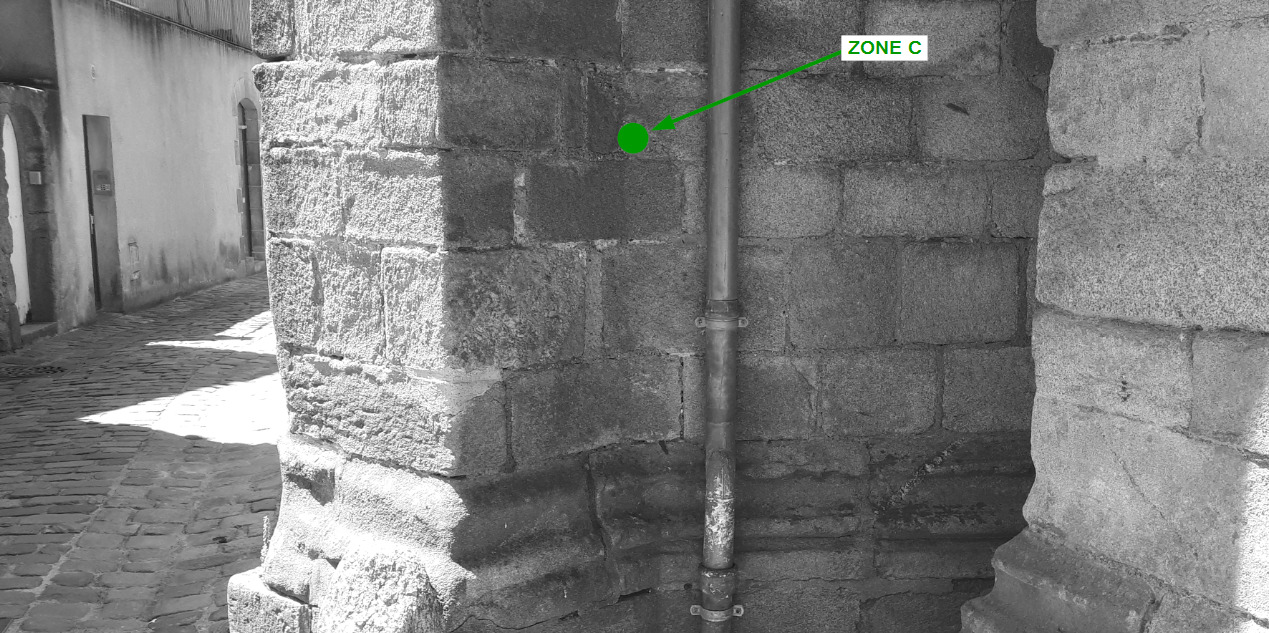
- Question 5 : Décrivez le phénocristal sous la zone verte, notamment sa couleur et sa structure cristalline. Déduisez-en la nature de ce phénocristal.
- Question 5 : Describe the phenocryst under the green area, including its color and crystal structure. Deduce the nature of this phenocryst.
Vous pouvez vous loguer sans attendre notre confirmation,
mais vous devez nous envoyer les réponses en même temps soit par mail via notre profil (
fafahakkai), soit via la messagerie geocaching.com (Message Center).
S'il y a des problèmes avec vos réponses nous vous en ferons part.
Les logs enregistrés sans réponses seront supprimés.Une photo de vous ou de votre GPS sur le site (mais sans les zones d'observation) est la bienvenue, mais n'est pas obligatoire.
You can log this cache without waiting for our confirmation, but you must send us the answers at the same time, by e-mail via our profile (fafahakkai) or by the system of Message Center of geocaching.com.
If there is a problem with your answers we will notify you. The logs recorded without answers will be deleted.
A photo of you or your GPS in Black & White on the site is welcome, but not mandatory.
Rappel concernant les « Earthcaches »: Il n'y a pas de conteneur à rechercher ni de logbook à renseigner. Il suffit de se rendre sur les lieux, de répondre aux questions ci-dessus et de nous renvoyer les réponses.
Reminder concerning "Earthcaches": there is neither a container to look for nor a logbook to sign. One need only go to the location, answer to the differents questions and send us the answers.